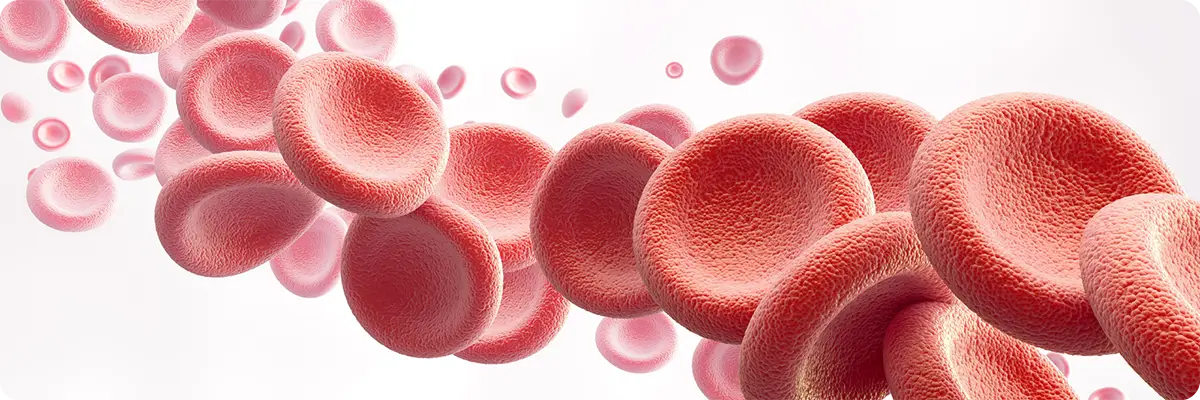Solutions
keyboard_arrow_downServices
keyboard_arrow_downSupport & Resources
keyboard_arrow_downCompany
keyboard_arrow_downContact
Glucose-6-phosphate dehydorgenase (G6PDH/G6PD) deficiency is an x-linked and sex-linked metabolic disorder, commonly affecting men more so than women1. The G6PDH enzyme is critical for the proper functioning of red blood cells (RBC's). Depleated levels of G6PDH can cause the premature destruction of RBC's (haemolysis). If the bone marrow cannot compensate for the reduction in RBC's, heamolyic anaemia can develop. It is important to note that a deficiency in the G6PDH enzyme is not enough to promote the onset of haemolysis, but rather additional factors are required to promote the onset of symptoms2.
Some of the common side effects of G6PDH deficiency include: paleness, dark urine, yellowing of the skin and whites of the eyes, a rapid heart rate and shortness of breath. Common triggers for the development of haemolytic anaemia in those who are G6PDH deficient include: bacterial and viral infections, certain drugs (medications and antibiotics to treat malaria), and favism (inhaling the pollen from fava plants and ingesting fava beans)3
G6PDH deficiency has been recognised as a significant cause of mild to severe jaundice in newborns. It has been noted that those with this disorder commonly will not experience any signs or symptoms making them unaware that they have the condition3
Haemolytic Anaemia
Haemolytic anaemia is an umbrella term used to describe the premature destruction of red blood cells (RBC's). This disorder encompasses numerous conditions including: autoantibodies, medications, underlying malignancy, bone marrow failure, infection and heredity conditions including sickle cell disease or haemoglobinopathies4 5.
The severity of haemolytic anaemia depends on whether the onset of haemolysis is gradual or rapid and on the extent of RBC destruction. Patients with mild haemolysis can be asymptomatic whereas the anaemia in severe haemolysis can be life-threatening and can cause angina and cardiopulmonary decompensation. Haemolytic anaemia is an intravascular phenomenon meaning that this type of haemolysis occurs within the blood vessels and is caused by the following conditions: prosthetic cardiac valves, glucose-6-phosphate dehydrogenase (G6PDH) deficiency, thrombotic thrombocytopenic purpura, disseminated intravascular coagulation, transfusion of ABO incompatible blood and paroxysmal nocturnal haemoglobinuria (PNH)6.
Heredity disorders can also cause haemolysis due to the erythrocyte membrane and haemoglobin abnormalities, and enzymatic defects. Some hereditary disorders include: G6PDH deficiency, hereditary spherocytosis and sickle cell anaemia6.
Glucose-6-phosphate dehydrogenase (G6PDH) is a cytosolic enzyme located on the X-chromosome found in bodily cells. G6PDH is involved in the normal processing of carbohydrates and plays a critical role in RBC, protecting them from damage and premature destruction. The two main products of G6PDH are ribose-5-phosphate which is important for DNA, the chemical cousin of RNA. The chemical reaction produces NADPH which protects bodily cells from reactive oxygen species1.
Benefits of the G6PDH Assay
A niche assay from Randox meaning that Randox are one of the only manufacturers to offer a G6PDH assay in an automated biochemistry format.
Superior stability of 4 weeks upon reconstitution and stored at +2°C to +8°C. Many other commercially available assays offer only 5 days stability, leading to product wastage.
Minimal interference as the sample pre-wash step included in the Randox G6PDH testing method serves to purify the sample, leading to no known interferences being observed.
Excellent correlation coefficient of r=0.99 when compared against other commercially available methods.
Lyophilised reagent for enhanced stability.
UV method
G6PDH controls offering a complete testing package.
Applications available detailing instrument-specific settings for the convenient use of the Randox G6PDH assay on a wide range of clinical chemistry analsyers.
DID YOU KNOW?
It is estimated that 400 million people globally are G6PDH deficient3.
The condition most commonly occurs in parts of Africa, Asia , the Mediterranean and the Middle East3.
More featured reagents
Read more about our vast range of assays



